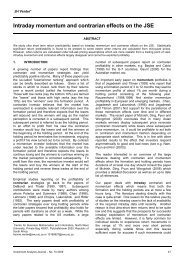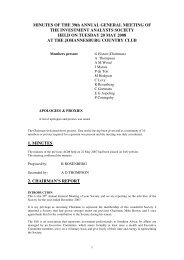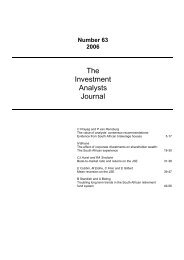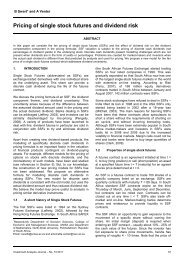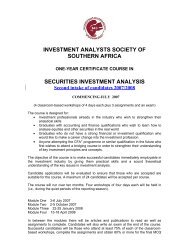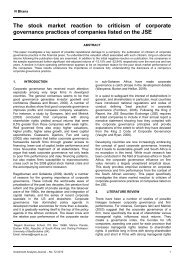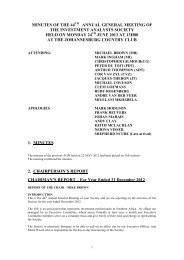Equity style timing - Investment Analysts Journal
Equity style timing - Investment Analysts Journal
Equity style timing - Investment Analysts Journal
You also want an ePaper? Increase the reach of your titles
YUMPU automatically turns print PDFs into web optimized ePapers that Google loves.
<strong>Equity</strong> <strong>style</strong> <strong>timing</strong><br />
Table 1: Comparative returns from the various strategies<br />
Perfect<br />
5<br />
Switches<br />
All Value<br />
Random<br />
All<br />
Growth<br />
Return to<br />
ALL Share<br />
Return to<br />
Industrials<br />
Index<br />
5 Bad<br />
Switches<br />
Imperfect<br />
Perfect 0,0% 13,2% 20,9% 22,3% 28,1% 29,1% 29,2% 36,8% 54,9%<br />
5 Switches -11,7% 0,0% 6,8% 8,0% 13,1% 14,0% 14,1% 20,8% 36,8%<br />
All Value -17,3% -6,3% 0,0% 1,2% 6,0% 6,8% 6,8% 13,1% 28,1%<br />
Random -18,3% -7,4% -1,2% 0,0% 4,7% 5,5% 5,6% 11,8% 26,6%<br />
All Growth -22,0% -11,6% -5,7% -4,5% 0,0% 0,7% 0,8% 6,8% 20,9%<br />
Return to ALL Share -22,5% -12,3% -6,3% -5,2% -0,7% 0,0% 0,1% 6,0% 20,0%<br />
Return to Industrials Index -22,6% -12,3% -6,4% -5,3% -0,8% -0,1% 0,0% 5,9% 19,9%<br />
5 Bad Switches -26,9% -17,2% -11,6% -10,6% -6,3% -5,7% -5,6% 0,0% 13,2%<br />
Imperfect -35,4% -26,9% -22,0% -21,0% -17,3% -16,7% -16,6% -11,7% 0,0%<br />
For example, the 5 switches strategy outperformed the All Share Index by 14%pa<br />
In order to ensure the model had predictive power the<br />
variables were lagged for three months relative to the<br />
dependent variable (AllV/AllG). A correlation analysis<br />
of the variables indicated that only the term structure,<br />
co-incident indicator, and earnings yield gap added to<br />
the explanatory power of the equation (Table 2).<br />
Table 2: Regression statistics for a three variable model<br />
Multiple R 73%<br />
R square 53%<br />
Adjusted R square 52%<br />
Standard error 11%<br />
Observations 85,0<br />
ANOVA Df SS MS F<br />
Regression 3 1,11 0,37 31,03<br />
Residual 81 0,96 0,01<br />
Total 84 2,07<br />
Coefficients Standard<br />
Error<br />
t-Stat P-<br />
value<br />
Intercept 0,47 0,20 2,35 0,02<br />
Term structure -0,11 0,02 -,687 0,00<br />
Co-incident indicator 0,01 0,00 4,09 0,00<br />
Earnings yield gap -0,02 0,01 -2,10 0,04<br />
Table 2 shows the regression statistics for an<br />
econometric model with three independent variables<br />
(viz: the term structure, the co-incident indicator and<br />
the earnings yield gap) to predict <strong>style</strong> turning points.<br />
6.6 Testing the predictive power of the<br />
regression<br />
In order to test the predictive ability of the model, a<br />
trading strategy was designed and tested using the<br />
out-of-sample data. It was assumed that the investor<br />
was fully invested in value shares at the beginning, i.e.<br />
January 1994. Using monthly output from the model<br />
and to minimise transaction costs, the following trading<br />
strategy was tested: “Switch to growth if the model<br />
indicates that the value/growth variable would narrow<br />
over the next two consecutive months. If either one of<br />
the following months showed an increase in the<br />
variable, then no switch was made.”<br />
Table 3 below presents the results of the analysis:<br />
As indicated in Table 3, the cumulative return of the<br />
trading strategy was lower than that from the perfect<br />
<strong>timing</strong> example, but nevertheless outperformed the All<br />
Share Index, the Industrial Index and the passive<br />
strategies of remaining in either value or growth over<br />
the entire period.<br />
7. INTERPRETATION OF RESULTS<br />
Fama and French (1998) showed that the value<br />
premium is a global phenomenon. This research<br />
affirmed their findings by showing the differential<br />
returns to investing in the different <strong>style</strong>s over a 20-<br />
year period in South Africa.<br />
The research also mirrored the findings of Lakonishok<br />
et al. (1994), and Capaul et al. (1993) that the value<br />
<strong>style</strong> outperforms growth over long periods of time. In<br />
addition, it also showed that this outperformance was<br />
cyclical, with growth sometimes outperforming value.<br />
The influence of size was significant, as predicted by<br />
Reinganum (1999). However, it was evident that the<br />
value effect occurred across the size spectrum, thus<br />
disagreeing with Reinganum (1981) who found that the<br />
value effect was a manifestation of the market<br />
capitalisation effect.<br />
The findings corroborated Van Rensburg (2001), Van<br />
Rensburg and Robertson (2003a, 2003b), Plaistow<br />
and Knight (1986), and Gates (1997) who found<br />
evidence for the value effect in South Africa.<br />
In contrast, the research did not corroborate Robins et<br />
al. (1999) who found no evidence of either the market<br />
cap effect or the value effect.<br />
The benefits of <strong>style</strong> <strong>timing</strong> were evident in the<br />
research. Following Christopherson and Williams<br />
(1997), <strong>timing</strong> had an influence in determining the<br />
returns to the <strong>style</strong> manager: If the value manager<br />
buys a share too soon, s/he may have to endure an<br />
extended period of under-performance. The same<br />
problem applies to growth managers.<br />
22 <strong>Investment</strong> <strong>Analysts</strong> <strong>Journal</strong> – No. 65 2007




